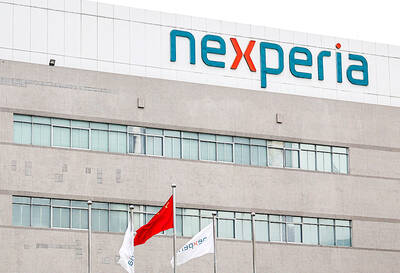High-tech companies from Taiwan plan to showcase 5G developments at the Mobile World Congress, which opened yesterday in Barcelona, the Ministry of Economic Affairs has announced.
For the third time, the ministry is partnering with the Industrial Technology Research Institute (工研院) to set up a Taiwan pavilion at the congress, which brings together the latest innovations in mobile communications.
Twelve companies would demonstrate technologies like 5G, artificial intelligence and the Internet of Things, the ministry said.

Photo: AFP
The pavilion would also display applications in smart-city development, it said.
The nation would be exhibiting smart-city achievements for the first time at the congress, the ministry said, adding that transportation, healthcare, governance, tourism, energy development, retail, agriculture and education applications would be demonstrated.
Several firms at the pavilion, such as wireless networking product supplier Edgecore Networks Corp (鈺登) and broadband application supplier Alpha Networks Inc (明泰), had previously only produced communications hardware, but have now expanded into software development, said Maggie Chao (趙國婷), a manager at the Communications Industry Development Project Office of the ministry’s Industrial Development Bureau.
At a time when the global tech sector is gearing up for 5G deployment, the firms have proved adept at integrating hardware and software capabilities, an advantage when looking for business opportunities, Chao said.
Pavilion exhibitors would display graphics chips, smart home systems, cloud technology, a data analysis platform for telecom customers, open networking solutions, multi-access edge computing and smart healthcare solutions, she added.
The ministry has worked with the Groupe Speciale Mobile Association, a congress organizer, to invite potential foreign buyers to see live demos at the pavilion in an effort to secure orders for the 12 firms, Chao said.
The congress, which runs until Thursday, expects to welcome about 2,000 exhibitors from around the world showing the latest mobile communications technologies.
Yesterday, HTC Corp (宏達電) unveiled its 5G smart hub that serves as a mobile hotspot with unprecedented data speeds for up to 20 users. The device enables bandwidth-intensive applications such as smooth 4K video streaming and low-latency gaming, and is equipped with a 12.7cm touchscreen to improve ease of use.
US and European carriers are to offer the product, HTC said in a statement.
The 5G hub handles cloud-based virtual reality (VR) applications, allowing users to stream VR content to a Vive Focus headset without relying on the computing power of a desktop computer, it said.
The 5G mobile hub is scheduled to go on sale in the second quarter of this year, according to HTC.
Intel Corp announced new chips and partnerships that it hopes will persuade investors that the billions of dollars poured into 5G research and development will pay off.
Intel said it has signed a deal with network gear makers Fibocom Wireless Inc, Arcadyan Technology Corp and others to include Intel modem chips in modules and gateways that help industrial equipment connect with 5G networks.
The firm also introduced new programmable chips to compete against Xilinx Inc, saying that it has reached deals with Ericsson AB and ZTE Corp (中興) to use Intel processors in their 5G networking gear.
Last week, ahead of the congress’ opening, South Korea’s Samsung Electronics Co and China’s Xiaomi Corp (小米) unveiled their foldable smartphones.
LG Electronics Co on Sunday unveiled a 5G smartphone with a dual screen and a second smartphone that could be unlocked without touching the screen, while Huawei Technologies Co (華為) introduced a new foldable smartphone compatible with 5G networks.
Additional reporting by Ted Chen

JITTERS: Nexperia has a 20 percent market share for chips powering simpler features such as window controls, and changing supply chains could take years European carmakers are looking into ways to scratch components made with parts from China, spooked by deepening geopolitical spats playing out through chipmaker Nexperia BV and Beijing’s export controls on rare earths. To protect operations from trade ructions, several automakers are pushing major suppliers to find permanent alternatives to Chinese semiconductors, people familiar with the matter said. The industry is considering broader changes to its supply chain to adapt to shifting geopolitics, Europe’s main suppliers lobby CLEPA head Matthias Zink said. “We had some indications already — questions like: ‘How can you supply me without this dependency on China?’” Zink, who also

The number of Taiwanese working in the US rose to a record high of 137,000 last year, driven largely by Taiwan Semiconductor Manufacturing Co’s (TSMC, 台積電) rapid overseas expansion, according to government data released yesterday. A total of 666,000 Taiwanese nationals were employed abroad last year, an increase of 45,000 from 2023 and the highest level since the COVID-19 pandemic, data from the Directorate-General of Budget, Accounting and Statistics (DGBAS) showed. Overseas employment had steadily increased between 2009 and 2019, peaking at 739,000, before plunging to 319,000 in 2021 amid US-China trade tensions, global supply chain shifts, reshoring by Taiwanese companies and

Taiwan Semiconductor Manufacturing Co (TSMC, 台積電) received about NT$147 billion (US$4.71 billion) in subsidies from the US, Japanese, German and Chinese governments over the past two years for its global expansion. Financial data compiled by the world’s largest contract chipmaker showed the company secured NT$4.77 billion in subsidies from the governments in the third quarter, bringing the total for the first three quarters of the year to about NT$71.9 billion. Along with the NT$75.16 billion in financial aid TSMC received last year, the chipmaker obtained NT$147 billion in subsidies in almost two years, the data showed. The subsidies received by its subsidiaries —

At least US$50 million for the freedom of an Emirati sheikh: That is the king’s ransom paid two weeks ago to militants linked to al-Qaeda who are pushing to topple the Malian government and impose Islamic law. Alongside a crippling fuel blockade, the Group for the Support of Islam and Muslims (JNIM) has made kidnapping wealthy foreigners for a ransom a pillar of its strategy of “economic jihad.” Its goal: Oust the junta, which has struggled to contain Mali’s decade-long insurgency since taking power following back-to-back coups in 2020 and 2021, by scaring away investors and paralyzing the west African country’s economy.